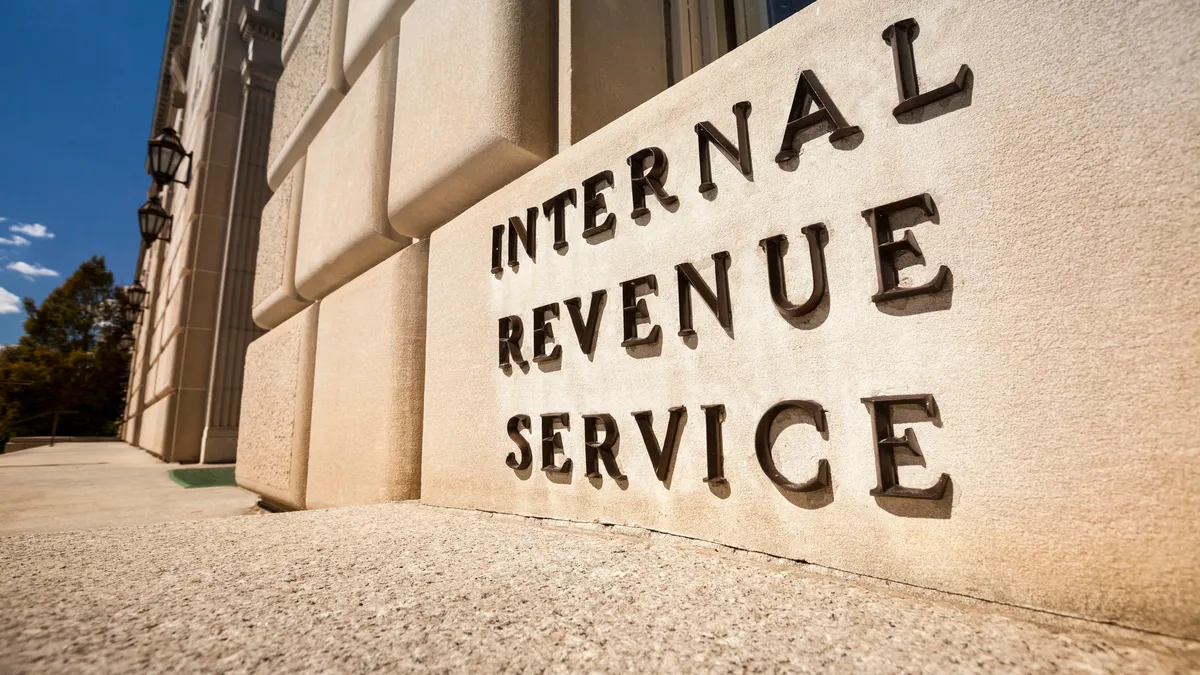Large U.S. drugmakers, tested by the pandemic and facing once again the looming threat of federal restraints on drug pricing, could soon come under another pressure: tax increases.
Pharmaceutical executives are already raising alarms about President Joe Biden's plan to raise corporate rates established in the tax law signed four years ago by his predecessor. CEOs of Eli Lilly and AbbVie, for instance, warn the proposal could harm their companies' competitiveness and that of their peers.
Their objections are to be expected after the tax cuts put in place by Donald Trump collectively saved large U.S. pharmas more than $6 billion over the past four years, according to a BioPharma Dive analysis.
The reductions in corporate tax bills did not, however, lead to consistent increases in direct employment at major domestic drugmakers — ostensibly a chief rationale of the Tax Cuts and Jobs Act of 2017, or TCJA. In the years since the bill was signed into law, the 10 biggest U.S. drugmakers collectively expanded their global workforces by less than 1% overall, BioPharma Dive found.
"Adding jobs was never a realistic goal of this law; it just gave the tax cuts marketing appeal with constituents back home," Michael Sinha, a research fellow at the Harvard-MIT Center for Regulatory Science at Harvard Medical School, said in an email.
Higher taxes, executives argue, will reduce the money available to spend on research and development, which builds the pipeline of new drugs that companies need to remain competitive. Others note Biden's proposed rate would again put the U.S. at a disadvantage compared to other countries.
"With respect to tax reform, we've heard a lot of rhetoric about a race to a bottom," Joseph Wolk, Johnson & Johnson's chief financial officer, said on a recent earnings call. "I don't know why folks are anxious to have a race to the top in terms of rates either."
Biden's proposed tax increase would also add to pharma's woes at a time when the sector is reeling from his administration's surprise support for waiving coronavirus vaccine patents.
Negative tax rate
The TCJA, in addition to cutting the corporate rate to 21% from 35%, also lowered levies on the repatriation of assets held overseas. The law set a tax of 15.5% on cash brought back and 8% on intellectual property, while also imposing a 10% tax on "excessive" returns.
The taxes tied to asset repatriation were a particularly critical provision for drugmakers, whose profits are tethered to intellectual property that can be easily placed in subsidiaries abroad.
At the time of the law's passage, every large U.S. pharma was paying less than the official rate due to deductions for R&D as well as other incentives. Afterward, the rates for most companies plummeted further, with AbbVie's calculated as effectively negative in both 2018 and 2020.
The table below compares tax rates in 2016, the last year before the TCJA affected rates, and in the years since.
U.S. based big pharma's tax liability
| Taxes paid, millions | Taxes paid, millions | Taxes paid, millions | Change, millions 2016-2020 | Tax rate | Tax rate | Tax rate | Change | |
| 2016 | 2018 | 2020 | 2016 | 2018 | 2020 | |||
| AbbVie | $1,931 | -$490 | -$1,224 | -$3,155 | 24.5% | -9.4% | -36% | -60.5% |
| Amgen | $1,441 | $1,151 | $869 | -$572 | 15.7% | 12.1% | 10.7% | -5% |
| Biogen | $1,237 | $1,426 | $992 | -$245 | 25.1% | 24.2% | 19.7% | -5.4% |
| Bristol Myers Squibb* | $1,408 | $1,021 | $2,124 | $716 | 23.8% | 17.1% | 15.6% | -8.2% |
| Eli Lilly | $636 | $530 | $1,036 | $400 | 18.9% | 14.9% | 14.3% | -4.6% |
| Gilead** | $3,609 | $2,339 | $1,580 | -$2,029 | 21.1% | 30% | 94.7% | 73.6% |
| Johnson & Johnson | $3,263 | $2,702 | $1,783 | -$1,480 | 16.5% | 15% | 10.8% | -5.7% |
| Merck & Co. | $718 | $2,508 | $1,709 | $991 | 15.4% | 28.8% | 19.4% | 4% |
| Pfizer*** | $1,123 | -$266 | $477 | -$646 | 13.4% | -7.4% | 6.4% | -7% |
| Regeneron | $434 | $109 | $297 | -$137 | 32.7% | 4.3% | 7.8% | -24.9% |
| TOTAL | $15,800 | $11,030 | $9,643 | -$6,157 |
*Acquired Celgene in 2019
**Effective tax rate in 2020 the result of acquisition-related charges and non-deductible changes in the fair value of Galapagos equity
***2018 tax liability was lowered by TCJA-related credits
Source: Company annual reports on file with the Securities and Exchange Commission
As biopharma executives were pondering use of their tax savings, many said they would make R&D a top priority, according to a Deloitte survey at the time. The survey also noted, however, that publicly disclosed actions revealed capital projects, share buybacks and increased dividends were the top three uses of funds.
A March 2020 report from investment firm SVB Leerink noted a similar prioritization, calculating that the biopharmaceutical companies it covers spent nearly $75 billion to buy back shares in 2018 and nearly $55 billion in 2019. Between 2017 and 2019, the U.S.-based drugmakers of Leerink's group spent a total of $140 billion on buybacks, led by Amgen’s nearly $29 billion.
A financial maneuver, buybacks essentially increase the valuation of all remaining shares, to the benefit of investors.
AbbVie, for example, announced a $2.5 billion capital projects plan in January 2018, shortly after the TCJA passed and as it calculated its future tax obligations. A few weeks later, it started a new $10 billion share repurchase program and in December of the same year, the pharma added $5 billion to the plan.
CEO Richard Gonzalez said in an April 30 conference call the company had added 1,500 jobs since the TCJA passed, although where that figure comes from is not immediately clear from the company's public disclosures. A company spokeswoman did not respond to a request for further details.
When counting the workers who joined AbbVie as part of its acquisition of Allergan in 2019, the combined company's employment rolls grew by only 100 between 2016 and 2020.
"Hopefully, as we go forward, there'll be a balance that's looked at in raising taxes, but also making companies maintain a competitive position and continue to be incented to invest in the U.S.," Gonzalez said.
In its annual report, AbbVie said its negative tax rate in 2020 was the result of a $1.7 billion benefit "related to changes in tax laws and related restructuring, including certain intra-group transfers of intellectual property and deferred tax remeasurement."
Placing intellectual property in low-tax jurisdictions like Ireland, where Allergan had its legal headquarters, is one way multinational corporations lower their tax bills. Payments from the parent to the overseas subsidiary can be designated as tax-deductible royalties that allow the parent to lower its taxable income.
Pfizer CFO Frank D'Amelio, speaking on a May 4 conference call, also argued the TCJA should stay in place. He claimed his company used savings from the law to add $1 billion to its pension plan as well as commit "a few billion" to fund development of its coronavirus vaccine.
"The 2017 tax reform leveled the playing field for U.S. multinationals against foreign competitors," said D'Amelio. "And that was an enabler, from my perspective, of much of what we've done with capital deployment, particularly in the U.S."
Modest increases in workforces
Across the entire economy, a report from the Federal Reserve Bank of Dallas estimated the TCJA tax cuts led to a 1% increase in gross domestic product growth and a 0.3% increase in job growth.
Looking only at U.S.-based large drugmakers, worker rolls increased by about 2,500 people globally and in the U.S. — for those companies that reported figures in both 2016 and 2020 — by just over 5,200. Many companies don't disclose their U.S. employee numbers in Securities and Exchange Commission filings, however, and didn't respond to BioPharma Dive requests to detail those statistics.
The low growth overall was driven in part by shrinking workforces at Pfizer and Lilly, which divested Upjohn and Elanco, respectively, during the four year period. All other companies increased their payrolls to varying degrees, although large jumps at AbbVie and Bristol Myers Squibb were the result of major acquisitions.
Two of the biggest employers, Pfizer and Merck & Co., have more than half of their total employees in overseas subsidiaries, which could limit the effect changes in U.S. tax rates might have on overall workforce growth.


That mix of employment probably wasn't affected by TCJA, Harvard's Sinha points out. The change to taxation of international profits — which aimed to allow corporations to repatriate cash "trapped" in overseas jurisdictions — gave companies no incentive to close overseas facilities and move jobs to the U.S.
"The incentive to offshore cash may have diminished to some degree, but the incentive to offshore production hasn't changed," he said.
Biden's tax plan would raise the base corporate rate to 28%, about halfway between the level set in the TCJA and the previous statutory rate. Biden would also impose a 15% minimum tax on "book" income, raise the rate on excessive overseas profits to 21% and calculate the tax on a country-by-country rather than global basis. The latter change is designed to prevent shifting of profits to maximize non-taxable income.
Under the TCJA, the global pooling of overseas revenue gave companies an incentive to shift profits into high-tax countries, where they could get credits to offset tax obligations to the U.S., a departure from the past practice of favoring low-tax jurisdictions, said Thornton Matheson, senior fellow at the Urban-Brookings Tax Policy Center.
"Before the TCJA we did observe in the tech and pharma industries — because they have these highly mobile, highly valuable intellectual property assets — that a lot of them had maneuvered into low-tax jurisdictions so they were able to compile this big war chest of offshore untaxed earnings," she said.
If the Biden overseas tax plan goes into effect, neither high nor low-tax jurisdictions will be favored because neither offers a significant advantage, she said.
The plan also envisions equalizing rates throughout the world — at 21%, the U.S. rate is in a tie for 17th-lowest of 37 in the Organization for Economic Co-Operation and Development — although that is the subject of talks among the industrialized countries.








